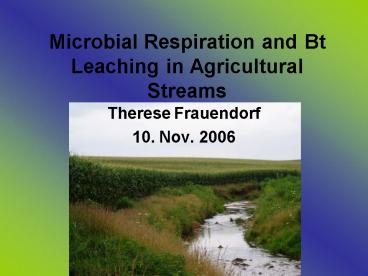Microbial Respiration and Bt Leaching in Agricultural Streams - PowerPoint PPT Presentation
1 / 15
Title:
Microbial Respiration and Bt Leaching in Agricultural Streams
Description:
What is the heterotrophic respiration along a stream, is it different among ... 0 0.621 mg O2/g AFDM/h (Central Appalachians, Southern Rockies, Central Valley) ... – PowerPoint PPT presentation
Number of Views:80
Avg rating:3.0/5.0
Title: Microbial Respiration and Bt Leaching in Agricultural Streams
1
Microbial Respiration and Bt Leaching in
Agricultural Streams
- Therese Frauendorf
- 10. Nov. 2006
2
Carbon Sources in Agricultural Streams
Forested Stream Light Litter Fall Allochthonous
Agricultural Stream Light Litter
Fall Autochthonous
Allochthonous Carbon input by corn byproducts
Allochthonous and Autochthonous Relative
components of Carbon Spiraling
3
Central Questions
- Does Bt leach out of corn leaves over short time
period of eight hours? - What is the heterotrophic respiration along a
stream, is it different among streams, and does
it change with temperature?
4
Bt (Bacillus thuringiensis)
- 35 of corn planted in the US was genetically
modified to express Bacillus thuringiensis - (Bt) d-endotoxin proteins
- Gut poison spilling of gut content into
hemolymph - Target species Coleoptera (Corn Borer) and
Lepidoptera (Root Borer) - Effect on non-target species Monarchs and
Caddisflies
5
Bt Leaching
- Bt Leaching determine the degree of the effect
on aquatic organism - Question How fast does Bt leach out of corn
leaves? - Long-term leaching
- (Shredders and up the food web)
- Short-term leaching
- (Filterers and water column)
6
Bt Methods
- Field
- DITCH 2005 site Brost
- 5 litter bags 15g dried corn leaves
- Take 0.5g of leaves out every half hour
- Total leaching time 8 hours
- Lab
- Add PBST extraction buffer (1g50ml)
- Homogenize centrifuge
- SDI Cyr1AB ELISA Plate
- read at 450nm and 650nm absorbance
7
Bt Results
Average of 5 replicates every half hour for eight
hours
Results suggest that short-term leaching occurs
mostly within the first hour
- Each of the 5 replicates every half hour for
eight hours - Linear Regression
- Showed a significant negative deviation from zero
- (F-ratio 23.379, plt 0.001)
Fine-print Time zero was done on a completely
different plate at a different time
8
Central Questions
- Does Bt leach out of corn leaves over short time
period of eight hours? - What is the heterotrophic respiration along a
stream, is it different among streams, and does
it change with temperature?
9
Carbon Spiraling
- Carbon Budget generally used, shows the total
benthic and transported carbon present, not know
where it is taken up and released - Carbon Spiraling can outline the cycling
pathway more detailed and apply to Carbon
Spiraling Indices
- Voc TOC x Q
- (m/day) BOC x w
- Koc Rhet
- (per day) BOC (TOC x z)
- Soc Voc
- (m) Koc
Voc (net longitudinal velocity of organic
carbon TOC (total transported organic carbon
concentration Q (discharge) BOC (total organic
carbon benthic standing stock w (mean river
width) Koc (the biotic turnover rate) Rhet
(heterotrophic respiration) z (mean water
depth) Soc (organic carbon turnover length)
10
Carbon Cycling
Measurement of heterotrophic respiration -
Oxygen consumption by microbial communities -
Measurement of microbial communities of
sediments ? substrate with most
microbial
11
Respiration Methods
- Collected Fine Benthic Organic Matter of a 60 ml
test tube area (5.27cm2)- filled to lip - 40 test tubes for four streams (DITCH 2006 sites
2A, 2B, 2D, 2F) - Tubes filled with water airtight and incubated
2hours in dark at 20C and 10C (incubator at
constant temperature) - Temperature and DO measured before and after
incubation - Substrate collected for AFDM
12
Respiration Result
- There is a significant difference in microbial
respiration per grams of AFDM (mg O2/g AFDM/h)
between sites and between the two temperatures - - 2-way ANOVA
- (Site F-ratio 14.835 plt 0.001, Temperature
F-ratio 40.776 plt0.001, Site x Temperature
F-ratio2.800 p0.04) - Hill et. al. 2000 0 0.621 mg O2/g AFDM/h
(Central Appalachians, Southern Rockies, Central
Valley) - There is a significant difference in microbial
respiration per cm2 (mg O2/ cm2/h) between sites
and between the two temperatures - - 2-way ANOVA
- (Site F-ratio 22.534 plt0.001, Temperature
F-ratio 44.441 plt0.001, Site x Temperature
F-ratio 4.783 p0.003)
13
Conclusion
- Bt-corn Short-term leaching
- - there is a significant decrease of Bt in corn
over eight hours suggesting a higher appearance
in the water column - - the most significant decrease is during the
first hour - - More to come repeat experiment, conduct a
short-term experiment for one hour with shorter
sample intervals - Microbial Respiration
- - there is a significant difference in
respiration between sites, which should be taken
into account when calculating the turnover rate
and length (high Rhet higher Koc and lower Soc) - - there is a significant difference in
respiration between temperatures, suggesting that
the carbon spiraling indices are temperature
sensitive - - More to come repeat experiment in
post-harvest season and compare to pre-harvest
respiration
14
Many Thanks!
- Jen Tank
- Natalie!
- Mia
- And the Tank Lab
15
Questions































